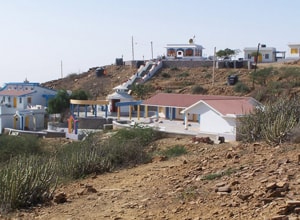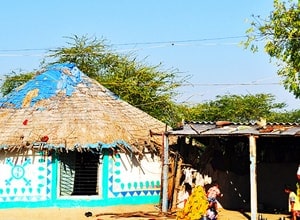





The Rann of Kutch is a salt marshy land in the Thar Desert in the Kutch district of western Gujarat. It lies between Gujarat in India and the Sindh province in Pakistan. It comprises of around 30,000 sq. km of land which includes The Great Rann of Kutch, The Little Rann of Kutch and Banni grassland.
The Rann of Kutch is famous for its white salty desert sand and is reputed to be the largest salt desert in the world.'Rann' means desert in Hindi which in turn is derived from the Sanskrit word 'Irina' which also means desert. The inhabitants of Kutch are called Kutchhi and have a language of their own with the same name. Most of the population in Rann of Kutch comprises of Hindus, Muslims, Jains and Sikhs.
For transport options one could hire a private vehicle from Bhuj which is 102 km from Rann. From December to February there are also regular buses plying from Bhuj and Ahmedabad to Rann. The nearest railway station and airport are also situated in Bhuj.
The climate in Rann owing to its desert land is considered to be one of the harshest and hottest temperatures recorded in India. The summer temperatures go as high as 50 degree Celsius. The winters are also quite extreme with temperatures dropping to as low as 0 degree Celsius. During the monsoon, the salt desert is covered with water considering its proximity to the Luni, Rupen and Indus rivers. The marshy desert is only about 49 feet above sea level.
The Rann of Kutch region is also home to a range of ecologically rich wildlife such as the flamingos and the wild ass that can be spotted around the desert often. Rann is also a part of a few sanctuaries such as the Indian wild ass sanctuary, Kutch desert wildlife sanctuary etc. It is a paradise for wildlife photographers and nature enthusiasts alike.
Due to its proximity to Pakistan, the Indian army has a base at Rann and has army officials patrolling around the area through the day. To visit Rann of Kutch, all travellers must have valid id proofs which are checked by the army official at the entry point.
The government of Gujarat holds a three month long festival known as 'The Rann Utsav' every year starting from December to February. This is the main source of income for the locals around who welcome visitors from across the globe to savour in local delicacies and to witness the culture and hospitality of Kutch.
At the utsav, there are different cultural events held everydays where travellers can stay in tented accommodations in the desert or can also opt for an authentic stay in mud houses a few kilometers away from the desert. Considering the magnitude of the festival, the accommodation at Rann is expensive during season time and hence it is advisable to pre-book if one wishes to visit the white desert during the utsav. Other than the festival months there is no accommodation option available in the desert, in this case one could opt to stay around Rann or could make a day trip from Bhuj.
Once at Rann Utsav the shopaholics can also indulge in buying authentic Gujarati handicrafts handmade by the Kutchhi people with a variety of options in clothes, bags and other items such as shoes and puppets.
During season, a variety of food options are also available at Rann starting from local chaats, Gujarati snacks to full fledged Gujarati thalis. Apart from the festival months, there are barely any options available for food. It is advisable to carry water and food if one wishes to visit Rann from March to November.
The best time to visit Rann is during the utsav, but for those who want to skip the crowds, a visit Kutch in November or March is a better option. A few other 'not-to-miss' spectacles at Rann are the sunset and the moon rise or a new moon night which adds to the beauty of the white desert by adding different shades of colours to the white sand. The Rann of Kutch is definitely a must visit place for anyone visiting Gujarat.

25 kms north of Khavda, the top of the Black Hills is the highest point in Kutch, at 462 m. From here, the entire northern horizon vanishes into the Great Rann, the desert and sky often becoming indistinguishable. It is one of the few non-coastal locations where you feel like you are at the edge of the earth, on the brink of incomprehensible vastness that fades off towards infinity. Looking out from the Black Hills, you can understand the tremendous effort that those who undertake the crossing of the Great Rann have to make. Since this is one of the places where a civilian can get closest to the Pakistan border, there is an Army post at the top; beyond here, only military personnel are allowed. The hill is also the site of a 400-year-old temple to Dattatreya, the three-headed incarnation of Lord Brahma, Lord Vishnu and Lord Shiva in the same body. Legend says that when Dattatreya walked on the earth, he stopped at the Black Hills and found a band of starving jackals. Being a god, he offered them his body to eat and as they ate, his body continually regenerated itself. Because of this, for the last four centuries, the priest at the temple has prepared a batch of prasad that is fed to the jackals after the evening aarti.

The Banni region emerged from the sea as a result of tectonic activities, received soils from the rivers flown from Bhuj mainland and ends in Greater Rann of Kutch. Soils deposited by the rivers and the wind, made the land of Banni richer enough that is could generate diverse grass species, once reported up to 40 grass species, mostly palatable with saline grass species. Banni grassland supports numerous animal genetic resources like Banni buffalo, Kankrej Cattle, Sheep, Goat, Camel, and horse. This grassland acts as breeding and nesting ground for more than 250 bird species, including resident, winter migratory birds. Banni region, situated at 23°19’N to 23°52’N to 68°56’E to 70°32’E, comprises around 3000 sq.km area under Bhuj taluka of Kutch district, is home of Muslim nomadic pastoralists and Meghwal Hindus. Pastoral lifestyle of the communities not only conserved its rich animal genetic resources but also protected the Banni grassland ecosystem.

This small village It was a cluster of about 20 houses and every member of the village is an artisan in some way. All the houses are made in the similar fashion - round and conical with mud brick roofs. The walls were painted with clay. Some were white-washed. It was very neat and clean.